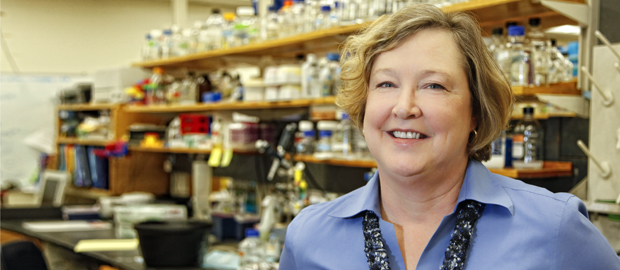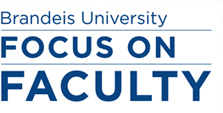Susan Lovett explores wreckage, repair of cells
Biology professor is to be inducted into American Association for the Advancement of Science
 Photo/Mike Lovett
Photo/Mike LovettSusan T. Lovett
Preventing cell DNA from mutating is critical to staving off diseases from autism to cancer. But what happens to DNA cells when they do mutate — can they be repaired?
“Cancer cells have a lot of genetic instability — mutations that give them properties that normal cells don’t have,” says Susan T. Lovett, a professor of biology whose work focuses on how organisms replicate their genome and ensure that what is there is maintained.
Lovett, who has been at Brandeis since 1989, has successfully investigated genetic phenomena such as mismatch repair, homologous recombination and template switching, all of which are implicated in human diseases like hereditary cancer, premature aging and some neuro-degeneration diseases.
 In recognition of her major contributions to understanding mechanisms of DNA repair and mutagenesis in bacteria, and for her service to the bacterial genetics community, she was recently elected to the American Association for the Advancement of Science (AAAS), the international non-profit organization, which publishes the journal Science, and is dedicated to advancing the understanding of science around the world. She will be in honored in Boston in February.
In recognition of her major contributions to understanding mechanisms of DNA repair and mutagenesis in bacteria, and for her service to the bacterial genetics community, she was recently elected to the American Association for the Advancement of Science (AAAS), the international non-profit organization, which publishes the journal Science, and is dedicated to advancing the understanding of science around the world. She will be in honored in Boston in February.
“In my lab we study the mechanisms by which changes come about and how cells—all cells— have mechanisms to prevent these changes.”
Lovett’s lab is involved in characterizing these mechanisms. One of the numerous projects people there are working on is a process called mismatch repair.
“When DNA is replicated there is a code,” says Lovett. “One strand of the double helix specifies what the code on the other strand is. If there’s a mismatch, there’s a system that detects that, then removes the error -- like deleting something on your computer. It is then resynthesized.”
Lovett’s lab has discovered enzymes that are involved in removing the mistake before it gets re-synthesized, a corrective process that is witnessed in bacteria and humans. A similar group of proteins are implicated in mutations. The proteins that recognize errors are mutated in a certain form of familial cancer called Lynch syndrome, a hereditary colon cancer.
Lovett says her lab uses bacterial systems to study these processes because these systems are so much simpler than those in humans: the genome is smaller, their lifespan is much shorter and they can be manipulated more easily.
The other nice thing about bacteria, Lovett says, is that they can grow them, so a coffee cup full of bacteria can contain millions and billions of cells-- which is important because if you’re looking for rare mutations or rare events, you have to have large populations.
“I think where my work has been important is in establishing a framework of thinking about repair processes,” says Lovett. “We’ve been very good at discovering new things, but it’s hard to discover things in human cells because of their complexity and the genetic screening that must be done.”
By using a simple organism, Lovett says it’s easier to discover things that are novel and unheard of. Once those mechanisms are understood, scientists investigate whether the same phenomena are present in human cells.
A breast cancer susceptibility gene turned out to be a protein that’s involved in homologous recombination (allowing a broken chromosome to find a partner). And the genes involved in homologous recombination, Lovett says, were first found in bacterial systems.
“All of our cells have a second copy of every gene,” says Lovett. “You can use this information to actually find the missing part and join those strands.”
The mechanisms that Lovett studies are all applicable to mechanisms that exist in humans and come into play in syndromes that have some kind of degeneration, such as immunological problems, premature aging and cancer. All of those diseases can be promoted by defects in DNA repair mechanisms.
Running a lab is like running a small business, says Lovett. You have employees, you have to get money through grants and awards, and you have to produce a product, which in her case is knowledge.
“You have to find your way through barriers and overcome obstacles,” says Lovett. “You have to train people so part of our business in a university setting is to train others to do what we do, which I take very seriously.”
Categories: Research, Science and Technology





